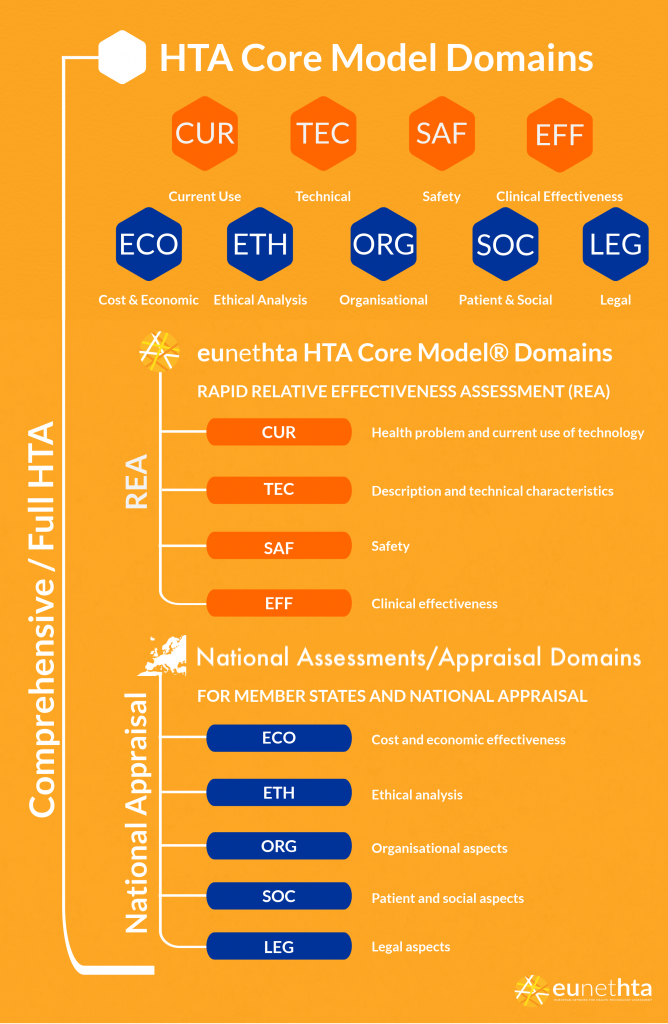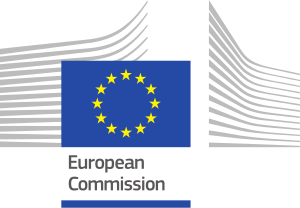Joint Clinical Assessment (JCA)
Joint Clinical Assessment (JCA) FAQs:
What is Health Technology Assessment (HTA)?
What is the HTA Core Model® and what are its nine domains?
What is the primary difference between a full report and a REA?
Who manages the production and how is it organised?
What should I do if I see a potential error in a EUnetHTA report?
What are the steps and timelines in the production process?
What is the role of a PICO question for a EUnetHTA Assessment?
What is our experience from EUnetHTA REAs in JA3?
What is health technology assessment (HTA)?
Health technology assessment is a multidisciplinary process that uses explicit methods to determine the value of a health technology at different points in its lifecycle. The purpose is to inform decision-making in order to promote an equitable, efficient, and high-quality health system.
Note 1: A health technology is an intervention developed to prevent, diagnose or treat medical conditions; promote health; provide rehabilitation; or organize healthcare delivery. The intervention can be a test, device, medicine, vaccine, procedure, program or system. (definition from the HTA Glossary)
Note 2: The process is formal, systematic, and transparent, and uses state-of-the-art methods to consider the best available evidence.
Note 3: The dimensions of value for a health technology may be assessed by examining the intended and unintended consequences of using a health technology compared to existing alternatives. These dimensions often include clinical effectiveness, safety, costs and economic implications, ethical, social, cultural and legal issues, organisational and environmental aspects, as well as wider implications for the patient, relatives, caregivers, and the population. The overall value may vary depending on the perspective taken, the stakeholders involved, and the decision context.
Note 4: HTA can be applied at different points in the lifecycle of a health technology, i.e., pre-market, during market approval, post-market, through to the disinvestment of a health technology.
The above definition was developed and agreed by INAHTA, HTAi, HTA Glossary English Editorial Board, ISPOR, RedETSA, HTAsiaLink and EUnetHTA, and published in May 2020 (see here).
Also, here is the link to the definition on the HTA Glossary.
What is the HTA Core Model® and what are its nine domains?
EUnetHTA developed the HTA Core Model®, which is a methodological framework for collaborative production and sharing of HTA information. The HTA Core Model® consists of the following nine domains:
What is relative effectiveness and what are EUnetHTA Rapid Relative Effectiveness Assessments (REAs)?
Relative effectiveness can be defined as to the extent an intervention does more good than harm, compared to one or more intervention alternatives for achieving the desired results when provided under the usual circumstances of health care practice.
EUnetHTA Rapid Relative Effectiveness Assessments (REA) are health technology assessments consisting of four domains in the HTA Core Model®.
The EUnetHTA Rapid REAs include the following four domains:
- Health Problem and Current Use of the Technology
- Description and technical characteristics of technology
- Safety
- Clinical Effectiveness
EUnetHTA decided to focus on these four elements because they are considered both important and transferable, i.e. usable in several countries. Besides these four domains, additional domains (i.e. economic evaluation, ethical, organisational, social and legal aspect of the introducing the technology) can be considered on a national level.
What is the primary difference between a full report and a REA?
If all nine domains are covered in an assessment, it is called a full HTA. The last five domains are considered more likely to be context specific, whereas the first four domains are considered both important and transferable (i.e. usable in several countries). Therefore, in the rapid REAs EUnetHTA only focuses on the first four domains of the HTA Core Model®. At a national level, HTA-bodies may of course complement the Rapid REA with other elements that are needed in their context, for the purpose of (coverage) decision-making.
The Rapid REAs are either conducted as Joint or Collaborative Assessments; however, they both follow the same high standard quality assurance procedures. The difference between them are mainly regarding use of submission file, involvement of stakeholders, scoping meetings with the industry and centralised coordination versus decentralised (Activity Centre Department Leads). Therefore, the production processes are slightly different in the two, to allow flexibility when it is feasible. The Collaborative Assessments are only relevant in the non-pharmaceutical field. The need for the two products is related to the different characteristics of the pharmaceutical field and in the medical devices/diagnostic tests field.
Who manages the production of JCA in EUnetHTA 21 and how is it organised?
The production of JCA on both medicinal products and medical devices is managed by the JCA Secretariat at Zorginstituut Nederland. The assessments should be fit for purpose, of high quality, of timely availability, and cover the whole range of health technologies. In addition, the production process is continuously refined and improved in order to best meet the needs of HTA-bodies, decision-makers and stakeholders.
More information in the initiation of an JCA will be provided soon.
What are CC licenses?
EUnetHTA uses Creative Commons (CC) licensing. This means that we retain copyright of published material, while allowing others to copy, distribute, and make some use of that work for non-commercial objectives. Every CC license works around the world and lasts as long as the applicable copyright lasts, since they are built on copyright. EUnetHTA uses ‘CC-BY-NC’ licenses for REAs and ‘CC-BY-SA’ licenses for guidelines. To find out more about these licenses, please read more at Creative Commons.
What should I do if I see a potential error in a EUnetHTA report?
EUnetHTA has an error reporting and correction procedure in place. If you see a potential error in the EUnetHTA report, please contact the secretariat at eunethta@zinl.nl and report the potential error. In your email, please clearly:
- State your affiliation and contact details.
- Describe as specific as possible the potential error you discovered (mention the title of the report (and the project ID), state both the page number and the specific sentence, and mark the error).
- If applicable, please also submit a reference to a source where the correct information can be found.
For further details on the process steps and the error classification, you can consult the dedicated process flow here.
What are the steps and timelines in the production process?
For more information about the production process, please contact JCA_Secretariat@zinl.nl
What is the role of a PICO question for a EUnetHTA Assessment?
The starting point for an assessment of a medical intervention is the formulation of a defined research question that should be answered by the assessment. In the context of EUnetHTA the research questions to be investigated are based on policy questions from the health care systems in which a HTA report should be used. Given the diversity of health care systems in Europe, it is possible that for a given medical intervention different policy questions are formulated by different partners.
The assessment of an intervention should not be data driven, i.e. the research questions should not be deduced from the available studies (either identified via an own information retrieval by the authoring team or submitted by the MAH/manufacturer). Rather, an appropriate translation of the policy question into a research question should be performed in the planning stage of the assessment. This means that the research question (the PICO – Population, Intervention, Comparator(s), Outcomes) is pre-specified for a given assessment.
For more information on what the PICO framework is, how the PICO is used, and if EUnetHTA has a standard process for developing a PICO question, please consult the PICO FAQ.


